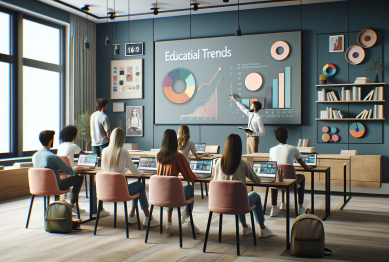Online learning has changed how students engage with education and society. This article explores strategies for making digital education more effective, accessible, and rewarding, examining trends, key challenges, and proven supports for learners.
Embracing the Shift to Digital Classrooms
Online learning platforms have become a critical part of education across the globe. With digital transformation, educators and students now interact in virtual spaces, expanding opportunities for both traditional and non-traditional learners. Many students experience flexibility in how and when they attend their lessons, allowing personalized schedules and individualized learning paces. The shift enables students from diverse backgrounds to participate in quality education without geographical restrictions. Even learners in rural areas can access a wide range of subjects by connecting through virtual platforms, removing historic barriers that limited educational equity.
Benefits of online education go beyond convenience. Interactive features like discussion forums, quizzes, and multimedia resources make learning more engaging and responsive. Many courses are tailored to student interests, with teachers able to monitor progress through digital dashboards. Technology also enables collaboration at a distance, encouraging project-based learning that builds teamwork and digital communication skills. These advancements enable a new generation of students to become comfortable working in digitally connected global environments.
While there are clear advantages to online learning, challenges remain for many students. Digital divides can affect access, especially for those without reliable internet or devices. Some learners may feel isolated, missing face-to-face classroom environments. However, creative schools and communities are addressing these issues with targeted programs, loaner devices, and digital literacy training to support every learner. Schools continue to prioritize efforts that reduce barriers, making digital classrooms as inclusive and effective as possible (Source: https://www.ed.gov/oii-news/personalized-learning).
Improving Digital Equity for Learners
Digital equity is central to successful online learning. Not all students come to digital classrooms with the same resources or support. Some face disadvantages related to broadband access, device ownership, or prior digital skills. Bridging these gaps is a major priority for educators and policymakers. Efforts such as subsidized internet programs, public Wi-Fi initiatives, and technology grants are bringing more equitable access to homes and communities (Source: https://www.brookings.edu/articles/bridging-the-digital-divide-for-k-12-students).
Supporting digital skill development is another important factor in digital equity. Many schools invest in dedicated tech lessons, parent workshops, and peer mentoring. These support systems increase confidence and competence, giving students the tools needed to thrive in virtual classrooms. Providing accessible technical support ensures that technology problems do not interrupt learning, especially for families who are new to online platforms. Practical strategies for digital inclusion strengthen education for everyone.
Targeted resources can benefit specific groups, such as students with disabilities. Schools may utilize features like screen readers, live captions, or alternative input devices to meet unique needs. Adaptive online platforms can further personalize learning experiences for every student. These initiatives contribute to fairer outcomes and help close achievement gaps in digital education. Equitable solutions in online learning boost not only participation but also student confidence and long-term success.
Maintaining Student Engagement in Virtual Environments
Engaging students in online classrooms requires thoughtful design and regular interaction. Teachers increasingly use multimedia content, interactive polls, and video meetings to hold student attention and make lessons memorable. Frequent check-ins, peer discussions, and project-based work help sustain engagement, especially over longer periods of remote learning. Personalized feedback can further motivate learners, offering clear paths for improvement and reinforcement (Source: https://www.edutopia.org/article/strategies-keeping-students-engaged-virtual-classroom).
Active engagement often depends on structured routines. Many educators adopt schedules, daily objectives, and success criteria to give students focus and predictability. Online platforms with gamification elements, badges, or leaderboards introduce a fun sense of competition and accomplishment. Flexibility allows students to work at their preferred times, while clear expectations keep learning organized and on track. Supportive digital communities, such as group chats or study circles, encourage shared learning and accountability among peers.
Motivation can dip in remote settings, but positive teacher-student relationships are key to keeping engagement high. Teachers who model curiosity, responsiveness, and encouragement help students stay connected to their academic goals. Involving families in the learning process can provide extra reinforcement and troubleshooting at home. By using diverse teaching methods and supporting student well-being, schools can cultivate a vibrant virtual learning culture that motivates and inspires.
Adapting Curriculum for Online Success
Curriculum adaptation is essential for effective digital instruction. Lessons designed for in-person teaching may not translate perfectly to virtual spaces. Educators often adjust by integrating short lectures, digital resource links, and hands-on assignments. Self-paced modules, recorded video instructions, and interactive simulations allow learners to review and revisit core concepts as needed. Adaptive curriculum helps meet students where they are, supporting both independent study and group collaboration.
Assessment methods have also evolved in online learning. Traditional tests may be supplemented by creative projects, digital portfolios, or open book assessments. These approaches privilege application and critical thinking over rote memorization. Online quizzes and assignments can provide instant feedback, helping students identify strengths and growth areas with every task. Flexible curriculum and assessment designs foster a sense of achievement while supporting mastery at an individual pace.
Many schools now include civic and digital citizenship lessons in their online curriculum. These teach students to navigate the web safely, recognize misinformation, and participate responsibly in digital communities (Source: https://www.commonsense.org/education/digital-citizenship). Encouraging awareness and resilience ensures that students are not only consumers of technology but also confident contributors to digital society. Lifelong learning attitudes develop as students build these critical skills in online classrooms.
Addressing Mental Health and Well-being in Remote Learning
Online education impacts more than academics—it also shapes student mental health. While some students enjoy greater flexibility, others may feel isolated or stressed by virtual expectations. Schools and community groups are raising awareness of these challenges, offering counseling services, online peer support, and mindfulness exercises. Social-emotional learning programs include strategies for managing emotions and staying connected, helping students adapt to new routines (Source: https://www.healthychildren.org/English/health-issues/conditions/COVID-19/Pages/Supporting-the-Children-of-Your-Community.aspx).
Parental support plays a vital role in student well-being during online learning. Family routines, open conversations, and regular check-ins offer reassurance and structure to children adjusting to remote study. Schools may partner with organizations to provide parents with tools for supporting their children’s learning and mental health at home. Community partnerships can address broader wellness needs, including food assistance and crisis support, for families navigating uncertain times.
Focusing on mental health cultivates resilience and academic perseverance. Encouraging breaks, exercise, and creative outlets balances screen time and promotes holistic development. Schools offering social activities, art, or physical education online help maintain important balance in student lives. When academic and emotional support systems align, online learners are better equipped to succeed and thrive in digital education settings.
Preparing for Lifelong Learning in a Connected World
As technology accelerates, lifelong learning has become vital in education and society. Online platforms offer ongoing access to new skills, career training, and community engagement far beyond the traditional school years. Students exposed to these opportunities early develop curiosity, adaptability, and confidence to pursue growth throughout life. These digital skills are critical for participating in knowledge economies and navigating complex modern societies.
Many educational systems encourage digital badges, online certifications, and micro-credentials that recognize skills gained outside the classroom. These options support diverse pathways for learners who may wish to reskill or advance, opening new doors in the workforce. Online learning is democratized, with universities and organizations offering open educational resources and free courses for global communities (Source: https://www.classcentral.com/report/mooc-stats-2023/).
Early adoption of online learning can inspire a lifelong passion for discovery. Students experience global perspectives, connect with mentors, and access specialized instruction that might not be available locally. Building digital networks prepares students for meaningful civic participation and leadership in digital society. As the educational landscape evolves, adaptability and continuous learning are more powerful than ever.
References
1. U.S. Department of Education. (n.d.). Personalized Learning. Retrieved from https://www.ed.gov/oii-news/personalized-learning
2. Brookings Institution. (n.d.). Bridging the digital divide for K-12 students. Retrieved from https://www.brookings.edu/articles/bridging-the-digital-divide-for-k-12-students
3. Edutopia. (n.d.). Strategies for Keeping Students Engaged in a Virtual Classroom. Retrieved from https://www.edutopia.org/article/strategies-keeping-students-engaged-virtual-classroom
4. Common Sense Education. (n.d.). Digital Citizenship Curriculum. Retrieved from https://www.commonsense.org/education/digital-citizenship
5. HealthyChildren.org. (n.d.). Supporting the Children of Your Community. Retrieved from https://www.healthychildren.org/English/health-issues/conditions/COVID-19/Pages/Supporting-the-Children-of-Your-Community.aspx
6. Class Central. (n.d.). MOOC Stats and Trends Report. Retrieved from https://www.classcentral.com/report/mooc-stats-2023/









